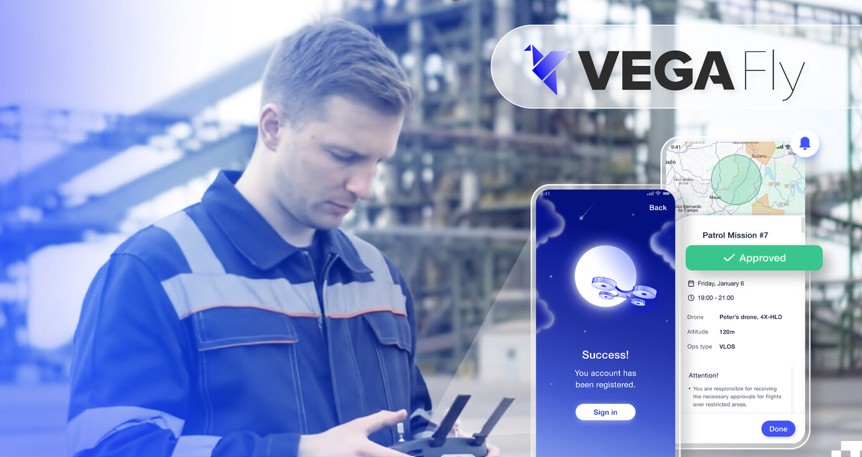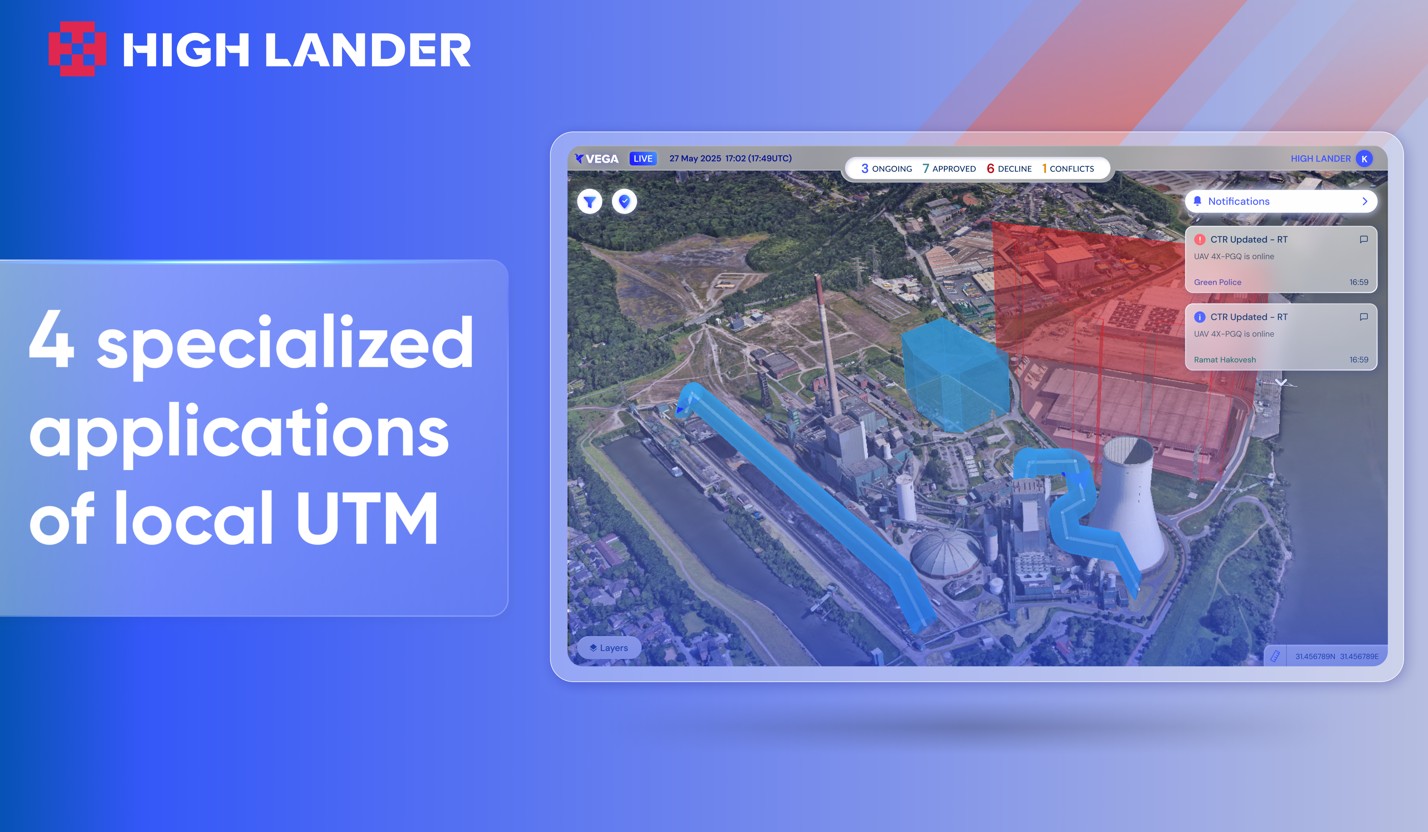News of national aviation authorities adopting UTM technology seems an everyday occurrence nowadays. This is not surprising; the number of commercial drone operations worldwide is already vast, and UTM is our way of facilitating their safe integration into national airspaces.
But UTM has additional applications: applied to localized airspaces, it’s a powerful enabler of professional drone operations at scale.
Following the launch of High Lander’s Vega HighSite, a localized UTM solution, we’ll look at a few of the practical applications of UTM technology at site-specific levels.
Industrial airspaces
Industrial sites are adopting drones into their operations because these precision aircraft exponentially improve their ability to carry out a wide range of critical tasks with greater frequency, accuracy and safety.
Where does UTM technology come in? It provides a centralized airspace management and situational awareness layer covering any defined airspace, including across multiple separate facilities. UTM enables site managers to see everything that’s going on in real time, while preventing costly and dangerous conflicts with autonomous strategic and tactical deconfliction protocols. It lets site managers set restricted areas, share vital geo-awareness data with drone pilots, and ensures that all aerial operations remain compliant with local airspace regulations.
The more complex the airspace, the more important these capabilities become. For example…
Port airspaces
Ports are amongst the largest and most complex ecosystems to be found in any country. Drones are taking on larger roles in these facilities too, a couple of key examples being Skyports and ST Engineering at the Port of Singapore.
The only way for port operators to effectively manage UAS activity in such complex airspaces is with UTM technology. Apart from the real-time airspace awareness, data-sharing, and deconfliction capabilities mentioned above, UTM provides registration and flight plan authorization functions enabling safe operation for as many operators and drones as needed. This capability also provides port authorities with a potential new revenue source, as they can enact a billing system for third-party drone operators who wish to fly in port airspace.
So we see that when dealing with ports, industrial facilities, mining operations, rail networks and other major operational facilities, localized UTM turns complex multi-faceted airspaces into safe, compliant, and revenue-generating ecosystems.
UTM has other applications too..

High-risk airspaces
In some airspaces, incursions from unidentified and/or unauthorized drones can have dire consequences. Airspace managers in such locations require solutions that manage and share airspace restrictions while also providing kinetic response to hazards.
UTM systems provide an answer. Within airspaces defined over sensitive sites, they seamlessly integrate with counter-UAS systems, enabling the detection, tracking and neutralization of unauthorized aircraft in sensitive areas. UTM enables the creation of dynamic restricted and prohibited zones and the dissemination of NOTAMs and alerts to friendly aircraft for efficient operational coordination. In such environments, data security is paramount – and UTM systems can offer hardened comms with end-to-end encryption, zero-trust architecture, and GNSS alternatives to protect sensitive data flows.
UAS technology sandboxes
As mentioned, many aviation authorities are investigating the adoption of UTM systems. But implementing new infrastructure at such scales is not a decision to be taken lightly. Aviation has the strongest safety record of all forms of transit thanks to air traffic control systems with proven technology and decades of deep operational experience; UTM is relatively untested.
Luckily, one of the benefits of localized UTM is the creation of UAS technology sandboxes. These projects fulfill two main purposes: first, they enable the development of UAS solutions and applications in safety including beyond visual line of sight (BVLOS) operations, together with the business development opportunities that such sites facilitate. Second, sandboxes enable aviation authorities to thoroughly stress-test UTM technology in preparation for live implementation. Examples of projects can be found in Brazil (the BR-UTM project), Kenya (the Konza National Drone Corridor), and Canada (RTM Phase 2).
Localized UTM thus provides a powerful tool for real-time protection and dynamic compliance.
Vega HighSite: end-to-end localized airspace management solution
In July 2025, High Lander Aviation, a global provider of UTM and drone fleet management software solutions, launched Vega HighSite, a localized airspace management suite for commercial and governmental facilities and territories.
Based on High Lander’s leading Vega UTM solution, HighSite is a service suite specialized to support the safe and compliant operation of drones at facilities and networks, including ports, national rail networks, industrial installations, oil and gas facilities both onshore and offshore, mining operations, and commercial complexes of all types and sizes.
The solution provides complete airspace awareness and facilitates the development, growth, and coordinated operation of UAS ecosystems of unlimited complexity, including BVLOS and autonomous operations.
It operates in conjunction with Vega Fly, a mobile app for drone pilots. Via the app operators register, create and submit flight plans for quick authorization, and receive up-to-the-minute geo-awareness data and alerts.

“The services of the Vega Hub were built for national-scale airspace management, and we have proved this capability. At the same time, aviation authorities and diverse organizations have conveyed to us a need for localized airspace management services for facilities like ports, industrial complexes, offshore sites, technology sandboxes, and municipal territories,” said Alon Abelson, CEO and founder of High Lander. “With Vega HighSite, we’re providing the professional-grade airspace management capabilities necessary to enable the seamless operation of drones at scale, with complete safety and compliance, and without the red tape.”
Features of Vega HighSite include live airspace awareness and monitoring; conformance monitoring; automated strategic and tactical deconfliction; streamlined flight plan authorizations; geo-awareness and restricted area management; integrated counter-UAS services; a weather advisory service; enhanced data collection and billing, and more. Vega services are hardware agnostic and modular, enabling High Lander to tailor solutions to the needs of each client.
For more information about the power of Vega HighSite, and to learn how it can support your aerial operations at any scale, follow the link below and don’t hesitate to get in touch for a demo.
https://www.highlander.io/highsite




